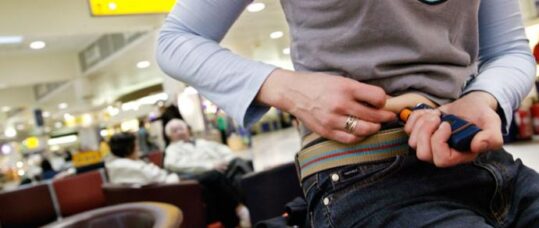Advice for people with diabetes when travelling

The essential preparation someone with diabetes should make before they travel is often taken for granted so it is crucial that nurses help them to think ahead.
While everyone should of course make plans regarding their health when travelling, it’s recommended that people with diabetes discuss plans for overseas travel with a health professional around four to six weeks before they depart.1 Therefore practitioners must plant the seed of health planning in their patients’ heads before they make a booking.
It’s important to find out if your patients with diabetes are planning to travel in the near future and if so, to take an extra few minutes to run through a checklist of precautions with them. This could mean the difference between a dream trip and a holiday from hell for your patient.
Whether it’s a week in the sun, a chilly city break, or a thrill-seeking adventure, every person with diabetes has needs specific to them, and every trip can present its own challenges for good management of their condition. As such, here are some practical tips you might want to bring up with your patients.
Airport security
Related Article: ‘Patients not prisoners’: Palliative care nursing behind bars
Advise your patients to keep some form of diabetes ID with them as well as a practitioner’s letter, explaining the need for their devices and medications, especially syringes and insulin.
As the use of new technology becomes more prolific in diabetes care, those using this technology need to be increasingly aware of how to navigate airports and other security settings. Practitioners should remind people with diabetes that insulin pumps and continuous glucose monitors should not be removed when going through security and they shouldn’t be exposed to x-rays or full body scanners either.
X-rays are bad news for pumps. At best, they can alter the computer and mechanism inside the pump, altering the amount of insulin delivered. At worst, they can completely shut the pump down. Neither is a good option for a person relying on a pump on holiday. Remind your patients that they have the right to decline a full body scan – although a search will be necessary instead. It is important to leave extra time for checking in and again, a letter from a healthcare professional can be very helpful in navigating these scenarios.
Although metal detectors are generally fine for machines, if in doubt advise your patients to check with the pump or continuous glucose monitor manufacturer and follow their recommendations.
Medication
Practitioners should recommend that their patients take double their usual supply of diabetes medication. As this may seem excessive to your patients, it’s useful to remind them that not all countries have the same access to insulin, or other diabetes medications, that we have here at home. Insulin may also only be available in a different strength, or be known under a different name, both of which can cause problems if your patients lose, break or are otherwise left without their usual medication.
Encourage patients to make a list of the diabetes-related supplies they will need for their trip, and to double-check it before they leave.
Advise people with diabetes to split their supplies into separate bags in case one is lost. However, patients should never put their insulin into their hold luggage as the freezing temperatures in the hold will destroy it, rendering it useless.
Travellers with diabetes should also pack extra snacks in their hand luggage in case their journey is delayed.
Related Article: NHSE confirms dates and eligibility for autumn Covid and flu jabs
Climate control
When discussing travel with your patients, make sure they give proper consideration to the seasonal climate of their chosen holiday destination. In hotter climates, blood vessels dilate and as a result both endogenous and exogenous insulin will work more effectively, increasing the risk of hypoglycaemia. Dehydration in hot weather also increases the risk of hyperglycaemia.2
Colder climates, however, can lead to an increase in appetite, which may mean your patient will need to alter how much medication they take. Your patient may not be aware of how heat and cold can affect their condition so talking them through this can keep them safe.
Foot care
Unfortunately for people living with diabetes, getting away from it all doesn’t mean getting away from being vigilant about diabetes-related complications. All practitioners should be sure to reiterate advice relating to good foot care, and carry out a foot check to identify any loss of protective sensation for patients planning to travel. Exposure to hot surfaces, such as walking barefoot on hot sand, can cause trauma and is one of the precipitating events linked with diabetic foot ulcers.3
Dan Howarth is a Diabetes Specialist Nurse, and Head of Care at Diabetes UK
Related Article: ‘Concerning acceleration’ in drug-resistant gonorrhoea ahead of vaccine programme
References
- Chandran M, Edelman S. Have Insulin, Will Fly: Diabetes Management During Air Travel and Time Zone Adjustment Strategies. Clin Diabetes 2003;21:82-5
- Johnson E, Bardis C, Jansen L et al. Reduced water intake deteriorates glucose regulation in patients with type 2 diabetes. Nutr Res 2017;43:25-32
- Ahmed Khan T, Sheikh M, Azher I, Sheikh A. Burn aggravated infected wart in a patient with type 2 diabetes: a medical challenge. BMJ Case Rep 2018;pii: bcr-2017-222897
Resources
- Diabetes UK. Travel & diabetes diabetes.org.uk/guide-to-diabetes/life-with-diabetes/travel

See how our symptom tool can help you make better sense of patient presentations
Click here to search a symptom


The essential preparation someone with diabetes should make before they travel is often taken for granted so it is crucial that nurses help them to think ahead.



